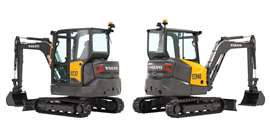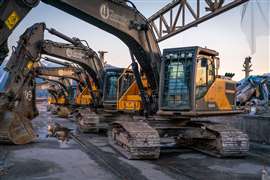Volvo reveals new compact excavators for North America
17 January 2024
Volvo Construction Equipment (Volvo CE) has replaced three of its compact excavator models with two new tracked models, the EC37 and the ECR40.
 Volvo CE’s ECR40 compact excavator. (PHOTO: Volvo CE)
Volvo CE’s ECR40 compact excavator. (PHOTO: Volvo CE)
Replacing the company’s EC35D, ECR35D and ECR40D machines, the new EC37 and ECR40 are designed specifically for contractors in North America.
They offer upgraded features for operator comfort and are said to be 10% more fuel efficient than the previous the company’s previous models, while also offering better stability and easier maintenance.
Darren Ashton, product manager — compact equipment at Volvo CE, said: “The 3- to 4-ton size makes up more than a quarter of the compact excavator market in North America, and we’re excited to refresh our offering in that range. I think our customers will be very happy with the improvements we’ve made based on their feedback.”
The mini excavators, which will be debuted at the upcoming ARA Show in New Orleans, Louisana, in February, both feature the Volvo D1.7A engine, which has a power output of 25 hp (18.5 kW) and an engine speed of 2,200 r/min.
Volvo CE said: “Work modes now include an ECO mode and an auto engine shutdown in addition to the existing auto engine idle. With auto engine shutdown, hours not worked are not recorded, keeping the machine operating efficiently for longer while reducing maintenance costs. This also contributes to a 10% boost in fuel efficiency.”
As well as incorporating the same platform and components, the models also share a number of other features. These include a breakout force of 35.5 kN (7,900 lbf), a slew speed of 9 rpm and a maximum travel speed of 4.6 km/h (2.86 mph).
The primary difference between the 3.5-t EC37 and the 4-t ECR40 is their tail swing radius. While the EC37 has a conventional tail swing design, the ECR40 is a more compact short swing radius excavator.
 The new EC37 and ECR40 will be debuted at the 2024 ARA Show in New Orleans. (PHOTO: Volvo CE)
The new EC37 and ECR40 will be debuted at the 2024 ARA Show in New Orleans. (PHOTO: Volvo CE)
Key new features of the EC37 and ECR40 include customisable hydraulic flow settings and work modes, which allow them to be used with a range of attachments and for a variety of applications.
They also have a new elongated undercarriage for increased stability and an adjusted center of gravity that Volvo CE says reduces the “rocking chair effect” that other compact excavators sometimes have.
Compared to the manufacturers previous EC35D, ECR35D and ECR40D models, the new mini excavators now also feature a more spacious, ergonomically designed cab.
The cabs of the EC37 and ECR40 have slim pillars and wider flat glass areas for greater visibility, a larger door opening and bigger travel pedals for easier use. For operator comfort, the cabs are also now equipped with an armrest and controls that float with the seat.
On the technology side of things, both excavators have “easy-to-navigate” HMI (human machine interface) functionalities that Volvo CE says provide controllability and adaptability for any job requirement.
Darren said: “The load-sensing hydraulics are definitely a highlight. The way the controls are set up and the smooth movements are just outstanding, and it all works together for better fuel efficiency.”
The manufacturer added: “If there are multiple operators working with the same machine, each person can set up the controls however they see fit with a few simple setting changes on the new 5-inch HMI.”
Both models are available for order now, with deliveries expected to start by the end Q1 this year.





